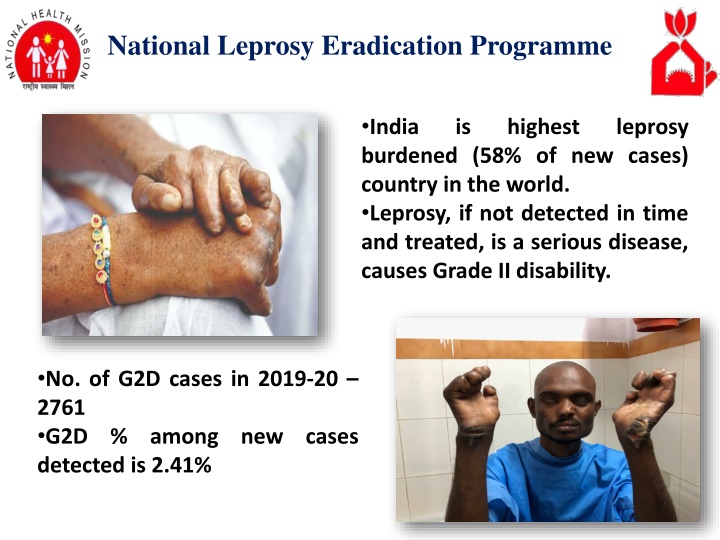
Leprosy Eradication Program in India - Overview and Goals
Learn about the National Leprosy Eradication Program in India, including its burden on the country, goals, current status, and activities. Discover how the program aims to reduce the prevalence of leprosy and prevent disabilities, with a focus on early detection and comprehensive treatment strategies.
Download Presentation

Please find below an Image/Link to download the presentation.
The content on the website is provided AS IS for your information and personal use only. It may not be sold, licensed, or shared on other websites without obtaining consent from the author. If you encounter any issues during the download, it is possible that the publisher has removed the file from their server.
You are allowed to download the files provided on this website for personal or commercial use, subject to the condition that they are used lawfully. All files are the property of their respective owners.
The content on the website is provided AS IS for your information and personal use only. It may not be sold, licensed, or shared on other websites without obtaining consent from the author.
E N D
Presentation Transcript
National Leprosy Eradication Programme India burdened (58% of new cases) country in the world. Leprosy, if not detected in time and treated, is a serious disease, causes Grade II disability. is highest leprosy No. of G2D cases in 2019-20 2761 G2D % among new cases detected is 2.41%
Goals- NLEP To reduce Prevalence rate less than 1/10,000 population at sub national and district level. To reduce Grade II disability % < 1 among new cases at National level To reduce Grade II disability cases < 1 case per million population at National level. Zero disabilities among new pediatric cases. Zero stigma and discrimination against persons affected by leprosy.
National Leprosy Status-India ANCDR - 8.13 per 100,000 popn. Prevalence Rate (PR) - 0.57 per 10,000 popn. Child proportion - 6.87 % Grade 2 Disability 2.41% G2D rate- 1.96 / million population. proportion-
Activities under NLEP Enhanced active and early case detection Convergence of leprosy screening under RBSK (for 0-18 yrs), RKSK (13-19 yrs), CBAC (above 30+ yrs population) and NUHM (to cover peri-urban, slums, colonies and migratory population). Timely referral and follow up for treatment completion on time through Multi Drug Therapy (MDT) available free of cost in all public health facilities. Disability prevention and Medical Rehabilitation (DPMR): Reaction management, provision of Self Care kits, MCR footwear and Aids & Appliance, and re-constructive Surgeries (RCS) at DH and medial colleges Sparsh Leprosy Awareness Campaigns.






















